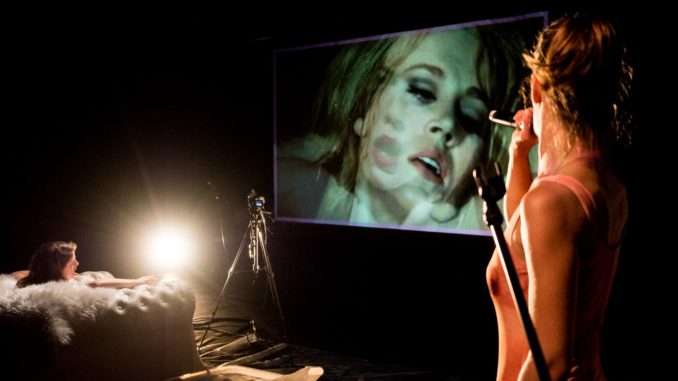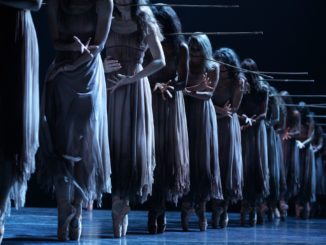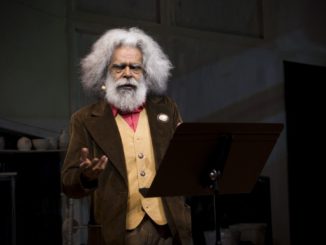
[Look Again]
Desire as an autonomous experience. Now there’s a novel idea. It’s no secret that sexual education across the board is still lacking, whether we’re talking about sexual orientation, contraception, or even basic female anatomy, but something that isn’t often spoken of is a woman’s power to experience and shape her own desire outside of the patriarchal lens. This is the conversation that the theatre makers behind Body Double aren’t afraid to jump into and get messy with.
Originally commissioned by BATS theatre as part of STAB, Body Double‘s Silo and Auckland Arts Festival season is once again performed by Julia Croft (The Plastic Orgasm, Power Ballad, If There’s Not Dancing in the Revolution then I’m Not Coming) and Karin McCracken (It’s a Trial, Jane Doe) with direction by Eleanor Bishop (Jane Doe, Boys). Along with Silo’s female led team, this makes for a strong female presence to kick start Silo’s 2018 season.
Touted as “a fearless new gaze on contemporary desire”, Bishop, Croft and McCracken have assembled Body Double as a response to the various narratives that shape and define women’s relationship to desire in their lives. Through their research into pop culture narratives they have found that sexual desire is predominately presented as heterosexual, women’s desire is secondary if at all present, and sex finishes when the man does. Within the eighty-minute visual spectacle, they seek to unpick these narratives and reinvestigate their relationship to desire.
As Body Double seeks to shirk off the patriarchal influences, it does the same with traditional storytelling methods, opting to subvert our expectations of what an evening out at the theatre might hold. Gone are the fourth walls, character arcs and traditional three-act structures. In their place we gain self-reflexive live commentary, beautiful integration and manipulation of live AV (nod to the entire design team and operators for such slick work – despite opening night issues), and of course, quite unforgettably, a situation with a raw chicken that you won’t ever quite forget (no spoilers – go see it for yourself). This production is incredibly engaging from start to finish. The sound design is perfectly reminiscent of the eager romance and excitement of teenage years using pop classics to bring us back to a different time in our lives. The visual design holds a delicate space between romantic and clinical, reminding us that even if the soft materials and rosy glow entices us we’re still here to dissect this narrative. The performances hold fast throughout a show that tests the endurance of both Croft and McCraken to their limits, and yet they still find moments to offer a sly wink to the women who share their frustrations.
The show takes shape and inspiration from Chris Kraus’ I love Dick, Roland Barthes’ critical theory, the classic novel Anna Karenina by Leo Tolstoy, and various romantic films such as the classic blockbuster Titanic, and The Notebook. The name of the show references the paradox that exists when wishing to both be the object and the one who desires, it also echoes the duality of the performers on stage, both enacting and recreating scenes of desire through their use of live cameras, choosing to focus in on themselves as desirable objects, but ultimately through their own parameters. Choosing to take control of how they are viewed is an act of reclaiming and reconceptualising female desire. It’s a personal revolution.
It’s clear that the material of the show is overtly heteronormative, white-centric, middle-class and focuses on the cis experiences of sex and desire. Perhaps this is because the show directly responds to popular culture that has been single-handedly dominated by the one-track white/cis desire narrative for so long. It also pays to note that the creators are also white/cis women. Either way, the content of the show may only feel accessible for those who fit within that cross section. Surprisingly, despite the incredibly self-aware commentary between the performers and the audience that holds the vignettes together, this isn’t addressed, which feels unusual when the opportunity to speak directly to an audience about the construction of the show and its content is already set up as a convention and utilised.
If you’re familiar with the work of these theatre practitioners then this show won’t be breaking much new ground for you, in the same way that Julia Croft’s If There’s Not Dancing in the Revolution, I’m Not Coming fearlessly reflected a mirror back upon pop culture’s direct influence on our perception of women’s bodies, Body Double investigates women as objects, but the specificity of the experiences presented limits the accessibility of the message to only a small portion of women. It begs the question: in 2018, where are the spaces for conversations about desire that welcome more diverse experiences in relation to sex in the media?
Both Croft and McCracken are captivating to watch. As they point out, each counter the other. Croft is like fire – constantly flickering, a little dangerous and unpredictable. McCracken is grounded – a calming presence, soothing the space that Croft ignites in her wake. They expertly guide us through the minefield of reconstructing desire, balancing out the moments of frustration with dry wit, acknowledging the absurdity in which they tread, as feminists, both desperately wanting to be… well that’s the problem, isn’t it? As women, most of us still don’t yet know what it is that we want, but we know WE want to choose .
Body Double is presented by Silo and Auckland Arts Festival in association with Zanetti Productions and plays at Q Loft until 29 March.




Leave a Reply